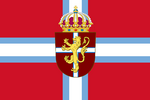Norrick
Loading map... |
Norrick (Norric: Nordrige, pronounced [noɐʀiː(jə)]), officially the Kingdom of Norrick, is a country in West Uletha. Norrick is a country, consisting of a mainland, together with an archipelago of several islands, which are mainly rock, made from ancient volcanic eruptions, and two mountain chains, a central mountain ridge, and a mountain ridge at its southern border. Norrick lies north of Vilvetia and west of Ruoguovvas. The Kingdom of Norrick is constitutionally a unitary state, comprising of several regions (amter). Constitutionally, Norrick is a unitary state, however, many of the regions act somewhat federally, each with their own priorities.
The Unified Kingdom of Norrick came to be in the late 12th century, when several smaller kingdoms united under a confederation under the rule of King Carl I. The area, which is today defined as Southern Norrick, was once a seperate entity, the Duchy of Surrick (Fyrstedømmet Søndrig), under a personal union with Norrick proper, however both nations unified in 1701, with the Treaty of Kongsby being signed, following a two-year war between the two states. In 1821, there was a civil war fought between the monarchy and the farmers in Norrick. There was no real winner of the war, and casualties were high. The two sides entered a ceasefire, however it was not long before the war would once again be initiated. This resulted in a fire in Kongsby in 1823, in which the King, King Gustav III, and the Burghers and Farmers, agreed to initiate peace, with the condition of an establishment of a Constitution. A constitution was subsequently established, which resulted in an elected Statsting, and an appointed Landsting, consisted of members appointed by the King. In 1895, civil unrest and an eventual civil war broke out between socialists and libertarians. This, at last, caused the government to concede to libertarians reducing government power to near-nothing. A constituional change was established in 1896. The role of the King was reduced significantly, making the kingship essentially become privatized. Constitutional amendments were subsequently established, notably in 1907, where women were given suffrage.
As a developed country, Norric people largely enjoy high standards of living through a high GDP, competitive entrepeneurship and a developed economy, including rights bestowed to them via the constituion, such as free speech, free assembly and freedom of religion.
Etymology
The word "Norrick" is an English word derived from the Danish word Nordrige, which means "North Realm". The earliest written evidence of the word "Nordrige" dates back to a 12th century stone table, with the words NOVRIC written upon it. The word "Nordrige" has also gradually evolved, starting with the first documented usage "NOVRIC", evolving into a bookform, 15th century document, with the words "NEVRICE" and "NORRICH" written on it, and further developing into a 17th century document with the word "NORRIG".
=History
Geography
Administrative divisions
Politics
Monarch
Legislature
=Judicial Authority
Economy
Taxation in Norrick
Demographics
Ethnic groups in Norrick
Norrick is an ethnically diverse country, especially in the southern regions of Norrick, below the main mountain ridge. The northern part of Norrick, above the main mountain ridge, is primarily populated by ethnic Northern Norric people, with some their variations of the Norric language being standard in the country. The more ethnically diverse southern part is populated by several ethnic groups: Northern Norric people, primarily in the cities, the Southern Norric people, historically agrarian people who were historically affiliated with some Kalmish ethnic subgroups, the Nestemian Ethnic Nation, a historically indigenous ethnoreligious society that has effectively merged with the Southern Norric people, although being genetically separate, the Krajovski people, a Slevic people, and the Jörukturkuaz People (Yörük Türküazları / Yöztürküazlar), a Turquese people.
The Krajovski and Jörukturkuaz People are primarily located in the western part of Southern Norrick around the Bredspire (Krajovski dialect: Bresbarsko Azero, Turquese: Birezber Gölü) around and in the towns of Christianskov (Kristijansko, Hirstiyaniye), Redna (Redzan, Reçne) and Moderby (Starmajka, Anaköy). The Nestemian Ethnic Nation is primarily located in towns including Johannessejr (Afkane), Skævinge (Askneri) and Stenborg (Astnibre).


